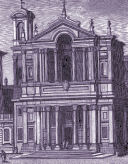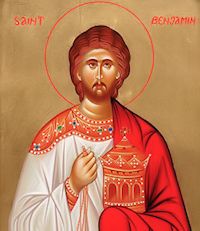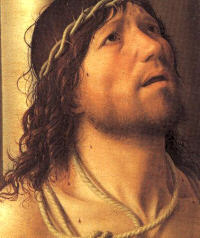Lent: March 31st
Tuesday of the Fifth Week of Lent
Other Commemorations: St. Benjamin, Deacon and Martyr (RM)
Free eBook:

|
| Free eBook: Liturgical Year 2023-2024, Vol. 4 |
» Enjoy our Liturgical Seasons series of e-books!
The world hates Christ because he bears witness to its evil works. As Christians we are charged to do the same. That is why if we are true Christians we will never be popular in the world. We should expect persecution and hatred to be heaped on us by the devil and his human agents.
Meditation - Christ's Last Days
Every person who loves Christ now tries his best to remain close to his suffering Savior during the last hours of His earthly life. The liturgy places us directly in the midst of the recorded events and expects us to participate. During these next days, therefore, we will traverse each road with Jesus.
Yesterday (Friday) He came with His disciples from the desert village of Ephrem to Jericho. When near the Jordan we heard from His lips the third prophecy of the crucifixion. Then Salome approached with her two sons, John and James, and begged important positions for them in the coming kingdom. This gave Jesus the opportunity to proclaim His wonderful teaching on humility. We stand close and listen.
The Lord enters Jericho. I am Zacheus, the chief publican, the little man who wants to see the Messiah from a tree. He looks up to me and says, "Today salvation has come to your house!" He stays two nights with me, a despised publican!
Over the Sabbath Jesus remains in Jericho. The next day (Sunday) He starts for Jerusalem at the head of a lordly caravan. Along the road there sits a blind beggar. It is I, again. "Jesus, Son of David, have mercy on mel" He heals my eyes, I see, I am enlightened!
In procession we pass through Jericho's inhospitable ravines up to Jerusalem. Night intervenes and Jesus stops at Bethany. He is joyously welcomed by Martha and Mary. Am I an active Martha or a meditating Mary? Possibly it was on this Sunday evening that the memorable meal took place when, with Lazarus present and Martha as hostess, Mary poured out the costly ointment for Jesus' burial. It was the act which estranged Judas completely from his Master.
In solemn procession on Monday afternoon the King of Israel comes to the top of Olivet, weeps over Jerusalem, and then continues on to the temple. We feel ourselves part of this festive procession, waving palms in our hands. We accompany our King and watch Him drive the money-changers out of His Father's house. Tuesday morning He returns with His disciples and while crossing Mt. Olivet curses the unfruitful fig tree, a figure of the Jewish people. This barren tree is likewise a warning for us.
Verbal encounters with the Jews take place in the temple courtyard until Wednesday afternoon when Christ hurls His eightfold curse upon Pharisee and Jew, and leaves the temple forever. With His disciples He then proceeds to the Mount of Olives and delivers His powerful discourse on the end of the world and the destruction of Jerusalem. Present in spirit we hear this sermon and take to heart His final admonition, "Be vigilant!" Meanwhile Judas has left the circle of disciples and offers his assistance to the chief priests.
Thursday morning Christ sends Peter and John from Bethany into the city to make the needed preparation for the Passover meal. As evening falls He bids farewell to His mother and His friends and goes with His apostles to the Upper Room in Jerusalem for His "Last Supper" with them.—In mind and in heart we will follow our Blessed Lord closely during these sacred days of Holy Week.

The Station in Rome was formerly the church of the martyr St. Cyriacus, and as such it is still given in the Roman missal; but this holy sanctuary having been destroyed, and the relics of the holy deacon translated to the church of St. Mary in Via lata, it is here that the Station is now held.
St. Benjamin
 The Christians in Persia had enjoyed twelve years of peace during the reign of Isdegerd, son of Sapor III, when in 420 it was disturbed by the indiscreet zeal of Abdas, a Christian Bishop who burned the Temple of Fire, the great sanctuary of the Persians. King Isdegerd threatened to destroy all the churches of the Christians unless the Bishop would rebuild it.
The Christians in Persia had enjoyed twelve years of peace during the reign of Isdegerd, son of Sapor III, when in 420 it was disturbed by the indiscreet zeal of Abdas, a Christian Bishop who burned the Temple of Fire, the great sanctuary of the Persians. King Isdegerd threatened to destroy all the churches of the Christians unless the Bishop would rebuild it.
As Abdas refused to comply, the threat was executed: the churches were demolished, Abdas himself was put to death, and a general persecution began which lasted forty years. Isdegerd died in 421, but his son and successor, Varanes, carried on the persecution with great fury. The Christians were submitted to the most cruel tortures.
Among those who suffered was St. Benjamin, a Deacon, who had been imprisoned a year for his Faith. At the end of this period, an ambassador of the Emperor of Constantinople obtained his release on condition that he would never speak to any of the courtiers about religion.
St. Benjamin, however, declared it was his duty to preach Christ and that he could not be silent. Although he had been liberated on the agreement made with the ambassador and the Persian authorities, he would not acquiesce in it, and neglected no opportunity of preaching. He was again apprehended and brought before the king. The tyrant ordered that reeds should be thrust in between his nails and his flesh and into all the tenderest parts of his body and then withdrawn. After this torture had been repeated several times, a knotted stake was inserted into his bowels to rend and tear him. The martyr expired in the most terrible agony about the year 424.
—Excerpted from Saints and Angels
Highlights and Things to Do:
- Read more about St. Benjamin:
- If you are named after St. Benjamin you can find a medal of him at the Catholic Company.
- St. Benjamin is also honored in the Eastern Orthodox Church and the Byzantine Rite Eastern Catholic Churches on October 13.

Friday of the Fifth Week of Lent
Station with Santo Stefano Rotondo al Celio (St Stephen's Rotunda at the Coelian Hill):
The Station, at Rome, is in the church of St. Stephen on Monte Celio (the Coelian Hill). The church is dedicated first to St. Stephen, the First Martyr, but is also dedicated unofficially to St. Stephen of Hungary. This is the Hungarian national church. This church is southeast of the Colosseum, off the usual beaten path. The actual site of the church was occupied by a set of barracks housing Roman soldiers. The earliest church was consecrated by Pope Simplicius between 468 and 483. Its architecture is unique in the Late Roman world and the oldest example of a circular church, often thought that it was modelled on the Anastasis of the Holy Sepulchre in Jerusalem. Although the inside is circular, the exterior is on a cruciform plan. The church has undergone various periods of ruination, disrepair, and restoration. The relics of the first martyr were never in the church.
Besides being one of the original churches in the round, another key feature is found on the walls of the church, decorated with numerous frescoes, portraying 34 scenes of martyrdom, commissioned by Gregory XIII in the 16th century. Each painting has a titulus or inscription explaining the scene and giving the name of the emperor who ordered the execution, as well as a quotation from the Bible.
For more information on Santo Stefano Rotondo al Celio, see:
For further information on the Station Churches, see The Stational Church.







